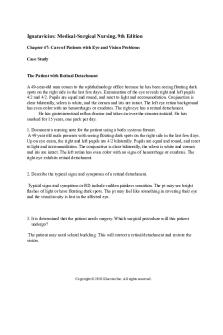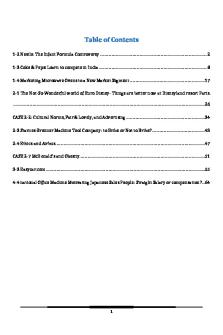Marketing case study ch 2.2.1 Primark PDF

| Title | Marketing case study ch 2.2.1 Primark |
|---|---|
| Course | Marketing |
| Institution | Fachhochschule Südwestfalen |
| Pages | 3 |
| File Size | 46.1 KB |
| File Type | |
| Total Downloads | 86 |
| Total Views | 130 |
Summary
Case study solutions...
Description
Marketing Ch 2.2.1 Case Study Primark
1) The analysis of the initial strategy situation deals with these areas The analysis of the global environment The analysis of the market conditions and The analysis of the company situation
a) Global Company environment
The development in society is an important macro-environmental factor which warrants a closer look The key success factor in fashion industry is to react quickly to changing market trends and to bring them into the shops of affordable prices It was certainly essential to understand changes in the values of fashion oriented As customers turned more and more fashion conscious and price sensitive, Primark understands promptly that it was of utmost importance to deliver the latest fashion in response to the customers’ needs very fast at very low prices. Thereby, Primark is recognized as a brand that offers a wide range of products at cheap prices and discount schema
b) Market Conditions Industries general market characteristics, customers in the market and competitors Market characteristics which refer to analyses of the market size, market growth and/or profit positively -> Primark open stores all over the World in the last year The customer analysis market segmentation -> young, fashion – conscious customers who wants to be trendy but cannot afford to spend a lot of money on fashion Those fashion-oriented customers who are best found in metropolitan areas. Primark’s first stores have been realized in big cities like Dublin, but the company has now spread its wing around the globe and also opens more and more shops in shopping centers Competitive environment, the five forces model could have shown that, in the apparel industry, important steps of the production chain (like design or the production itself) are often outsourced to economize on resources (like financial resources); instead, financial resources are then invested in advertising the brand
c) Company situation Analysis with respect to the buyers in the market, the company’s own customers, and the competitive environment, important instruments here are the value chain analysis
2) Competitive advantage is an advantage over competitors gained by offering consumers greater value, either by means of lower prices or by providing greater benefits and services that justifies higher prices In order to be relevant, competitive advantage accrue if They are based on attributes relevant and important to customers They can be perceived by customers They are sustainable (i.e. not quickly adaptable /imitable by competitors) The value chain analysis model was introduced by Porter and identifies sources of customer benefits and thus potential competitive advantages that are embedded in individual company activities When looking at the primary activities, 3 important steps of the value chain can be identified for apparel companies like Primark; these are The design The production The distribution The process begins with the design. Primark employs own designers but also works with external partners for the creation of the cloths -> advantage: very close to the customers/up-to-date, innovative and fast The production is the next step is facilitated by companies in Asia -> advantage: Very low price in the production, low wholesale prices and logistic costs The distribution is another step of the process orchestrated by the company. Products are shipped to 2 distributors centers in Britain and are limited in quantity -> the added value originates in very cost efficient logistics as it means that the company can keep its stocks low As Primark has never run on advertising campaign, hardly any expenditure was caused by this activity -> the added value comes from the low costs. Resources are economized and can be invested in other activities All Primark’s operations: Design Production Distribution These operations are coordinated from the company’s headquarters situated in Britain -> valueadded: as the headquarters retains the complete control of every part of its business, the company can reach flexibility and fast to changing trends All these primary activities help that processes are fast, flexible and close to the customer. With regard to the company infrastructure, Primark has a unique image
Primark has built up more than 180 stores all over Europe; on one hand, this underlines the company’s success. On the other hand, this leads to the good position that implies closeness to the market. Changing market tends in the whole world can be identified quickly so Primark is able to supply the fashion-conscious customers with the latest fashion immediately All these steps are able to generate value and finally offer newness and exclusivity which is so important for the fashion – conscious in the value chain => if created on important competitive advantage through not only selling very cheap but also stylish clothes and other products. The company saves advertising budget. 3) Market segmentation is one of the most fundamental concepts in marketing -> refers to the process of dividing a market into distinct groups of customers that are similar with respect to particular aspects
Possible segmentation criteria for Primark are: Geographical= “Customers within 10 miles of the M25” => Customers, location, region, urban/rural, classification Demographic = “A level & University Students” => Age, gender, occupation, socioeconomic group Behavioral = “customers wanting a value for money impulse buy” => Rate of usage, benefits sought, loyalty status, readiness to purchase Psychographic = “Customers who prefer to buy fair trade food” => Personality lifestyle, attitudes, class Benefit segmentation uses causal variables to group customers and focuses on how people assess the different benefits a product offers The perceived value Benefit or advantage consumers perceives that they receive from a product or service You can segment the market based upon quality, performance, customer service, or special features. For Primark especially one important segment with a specific benefit structure can be identified In the segment “price sensitive” customer seek for cheap prices as the most relevant decision criteria =>...
Similar Free PDFs

Case Study Marketing 301
- 3 Pages

Luxury Marketing Case study
- 19 Pages

Marketing Case Study #2
- 14 Pages

Case study assignment marketing
- 3 Pages

Lululemon marketing case study
- 7 Pages

Zara-Marketing case study
- 3 Pages

Case study ch 2
- 3 Pages

Primark-full
- 122 Pages

Marketing case study Hyundai Maruti
- 14 Pages

IPL Case Study- Marketing Management
- 14 Pages
Popular Institutions
- Tinajero National High School - Annex
- Politeknik Caltex Riau
- Yokohama City University
- SGT University
- University of Al-Qadisiyah
- Divine Word College of Vigan
- Techniek College Rotterdam
- Universidade de Santiago
- Universiti Teknologi MARA Cawangan Johor Kampus Pasir Gudang
- Poltekkes Kemenkes Yogyakarta
- Baguio City National High School
- Colegio san marcos
- preparatoria uno
- Centro de Bachillerato Tecnológico Industrial y de Servicios No. 107
- Dalian Maritime University
- Quang Trung Secondary School
- Colegio Tecnológico en Informática
- Corporación Regional de Educación Superior
- Grupo CEDVA
- Dar Al Uloom University
- Centro de Estudios Preuniversitarios de la Universidad Nacional de Ingeniería
- 上智大学
- Aakash International School, Nuna Majara
- San Felipe Neri Catholic School
- Kang Chiao International School - New Taipei City
- Misamis Occidental National High School
- Institución Educativa Escuela Normal Juan Ladrilleros
- Kolehiyo ng Pantukan
- Batanes State College
- Instituto Continental
- Sekolah Menengah Kejuruan Kesehatan Kaltara (Tarakan)
- Colegio de La Inmaculada Concepcion - Cebu





